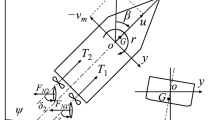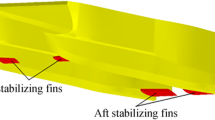Abstract
A mathematical model of a single-propeller twin-rudder ship has been developed from captive and free running model experiments. An open water rudder experiment was carried out to figure out the characteristics of the rudder. Captive experiments in a towing tank were carried out to figure out the performance of a single-propeller twin-rudder system on a large vessel. Interactions between the hull, propeller and twin rudders, including mutual interactions between the twin rudders, were expressed with several coefficients that were calculated from the experimental results at various ship speeds. In the analysis, the unique characteristics of a single-propeller twin-rudder ship, which affects rudder forces, were explained and formulated in the mathematical model. The captive model tests were conducted with zero ship’s yaw rate, so the interaction coefficients, which are influenced by the yaw rate, are determined from free running model experiments. Validation of the mathematical model of a single-propeller twin-rudder system for a blunt body ship is carried out with an independent set of free running experiments, which were not used for determining the interaction coefficients. The validated numerical model is used for carrying out simulations. Based on simulation results, some recommendations have been proposed for installing a single-propeller twin-rudder system.




















Similar content being viewed by others
Abbreviations
- a H :
-
interaction force coefficient induced on ship hull by rudder normal force
- A R :
-
rudder area
- B :
-
ship breadth
- C b :
-
block coefficient
- C N :
-
rudder normal force coefficient
- C 1, C 2, C 3 :
-
coefficients of polynomial representing propeller open water thrust characteristics
- d :
-
ship draft
- D P :
-
propeller diameter
- f RS, f RP :
-
decrement ratio of inflow velocity for starboard and port rudder
- F NS, F NP :
-
rudder normal force for starboard and port rudder
- F NSM, F NPM :
-
measured rudder normal force in experiment for starboard and port rudder
- h R :
-
rudder height
- I zz :
-
yaw moment of inertia
- J :
-
real propeller advance ratio
- J s :
-
apparent propeller advance ratio
- J zz :
-
added yaw moment of inertia
- K T :
-
propeller thrust coefficient
- k x :
-
coefficient indicating the rate of rudder inflow acceleration due to the propeller
- L :
-
ship length
- l RS, l RP :
-
flow straightening coefficient of yaw rate for starboard and port rudder
- m :
-
ship mass
- m x :
-
added mass in surge
- m y :
-
added mass in sway
- n :
-
propeller revolution
- r :
-
yaw rate of ship
- R(u):
-
ship resistance
- s :
-
propeller slip ratio
- S W :
-
ship’s wetted surface area
- T M :
-
measured propeller thrust in experiment
- t P0 :
-
thrust deduction factor in straight running
- t P :
-
thrust deduction factor in maneuvering
- t R :
-
coefficient for deduction of rudder drag
- u :
-
surge velocity
- \( U = \sqrt {u^{2} + v^{2} } \) :
-
ship velocity
- u RS, u RP :
-
inflow velocity in surge direction to starboard and port rudder
- u RSM, u RPM :
-
rudder inflow velocity calculated with measured rudder force for starboard and port rudder
- u RSP, u RPP :
-
rudder inflow velocity due to propeller for starboard and port rudder
- v :
-
sway velocity
- v RS, v RP :
-
inflow velocity in sway direction to starboard and port rudder
- x G :
-
location of center of gravity of ship in x-axis direction
- x H :
-
location of acting point of interaction force induced on ship hull by rudder normal force
- x P :
-
location of propeller in x-axis direction
- x R :
-
location of rudder in x-axis direction
- x t :
-
location of center of gravity of ship’s added mass in x-axis direction
- X M :
-
measured force in x-axis direction during captive model test
- w P0 :
-
effective propeller wake fraction in straight running
- w P :
-
effective propeller wake fraction in maneuvering
- w RS, w RP :
-
effective wake fraction for starboard and port rudder
- α RS, α RP :
-
effective rudder inflow angle of starboard and port rudder
- β :
-
drift angle of ship
- δ S, δ P :
-
angle of starboard and port rudder
- δ S0, δ P0 :
-
hydrodynamic neutral angle of starboard and port rudder
- δ SP, δ PS :
-
variation of inflow rudder angle due to interaction between starboard and port rudder
- ε S, ε P :
-
ratio of effective wake fraction in way of propeller and rudder
- ρ :
-
water density
- γ RS, γ RP :
-
flow straightening coefficient of sway velocity for starboard and port rudder
References
The Naval Architect (1985) The Royal Institution of Naval Architects, London, April issue:E185
Hasegawa K, Kang DH, Sano M et al (2006) Study on maneuverability of a large vessel installed with a mariner type Super VecTwin rudder. J Mar Sci Technol 11:88–99
MMG (1980) MMG report V (in Japanese). Bull Soc Nav Archit Jpn 616:565–576
Lee SK, Fujino M, Fukasawa T (1988) A study on the manoeuvring mathematical model for a twin-propeller twin-rudder ship (in Japanese). J Soc Nav Archit Jpn 163:109–118
Lee SK, Fujino M (2003) Assessment of a mathematical model for the manoeuvring motion of a twin-propeller twin-rudder ship. Int Shipbuild Progress 50:109–123
Yoshimura Y, Sakurai H (1989) Mathematical model for the manoeuvring ship motion in shallow water (3rd report)—Manoeuvrability of a twin-propeller twin-rudder ship (in Japanese). J Kansai Soc Nav Archit Jpn 211:115–126
Kobayashi H, Ishibashi A, Shimokawa K et al (1994) A study on Mathematical model for the maneuvering motions of twin-propeller twin-rudder ship (in Japanese). J Jpn Inst Navig 91:263–270
Yumuro A (1984) Some experiments on rudder force of a twin-screw ship with a single rudder (in Japanese). J Kansai Soc Nav Archit Jpn 194:53–64
Hamamoto M, Enomoto T (1997) Maneuvering performance of a ship with VecTwin rudder system. J Soc Nav Archit Jpn 181:197–204
Proceedings of 15th ITTC (1978) Appendix to the report of the performance committee of the 15th International Towing Tank Conference
Kobayashi E, Kagemoto H, Furukawa Y (1995) Mathematical models of maneuvering motions (in Japanese) In: Research on ship maneuverability and its application to ship design, Proceedings of the 12th marine dynamic symposium, pp 23–89
Lewis EV (1988) Principles of Naval Architecture second revision, vol II, SNAME, Jersey City
Hirano M (1980) On calculation method of ship maneuvering motion at initial design phase. J Soc Nav Archit Jpn 147:144–153
Holtrop J (1984) A statistical reanalysis of resistance and propulsion data, International Shipbuilding Progress, 31:272–276
Hasegawa K (1980) On a performance criterion for autopilot navigation. J Kansai Soc Nav Archit 178:93–104
Kose K, Hosokawa M, Yamada H et al (1992) A study on performance estimation of special rudders (in Japanese). Trans West Jpn Soc Nav Archit 84:49–57
Toda Y, Stern F, Tanaka I, Patel VC (1990) Mean-flow measurements in the boundary layer and wake of a series 60 Cb = 0.6 model ship with and without propeller. J Ship Res 34:225–252
Mori M (1974) Calculation of normal force of rudder behind propeller (in Japanese). J Kansai Soc Nav Archit 153:81–90
Kang DH, Hasegawa K (2007) Prediction method of hydrodynamic forces acting on the hull of a blunt-body ship in the even keel condition. J Mar Sci Technol 12:1–14
Kang DH (2006) Maneuvering mathematical model of blunt-body ship installed with mariner type VecTwin rudder. Doctoral thesis, Osaka University
Acknowledgments
Japan Hamworthy Co. Ltd. has initiated this research and offered the authors an opportunity to take part in and provide the maximum convenience. The authors would like to show their gratitude for their collaboration and contribution.
Author information
Authors and Affiliations
Corresponding author
Appendix
Appendix
The numerical values of regression coefficients of different regression functions shown in the paper are presented in this appendix. In the figures, for ease of understanding, all the angles have been shown as degrees. However, all the regression coefficients presented here were estimated considering angles in radians (Tables 6, 7, 8, 9, 10 and 11).
About this article
Cite this article
Kang, D., Nagarajan, V., Hasegawa, K. et al. Mathematical model of single-propeller twin-rudder ship. J Mar Sci Technol 13, 207–222 (2008). https://doi.org/10.1007/s00773-008-0027-0
Received:
Accepted:
Published:
Issue Date:
DOI: https://doi.org/10.1007/s00773-008-0027-0




